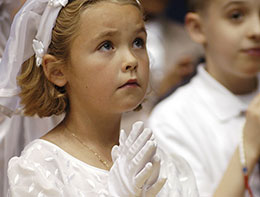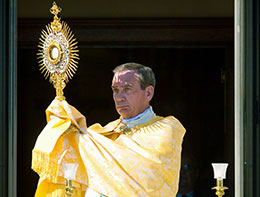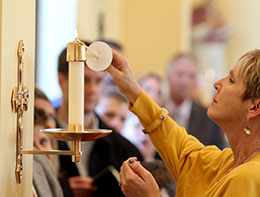Missionary zeal and rural resourcefulness
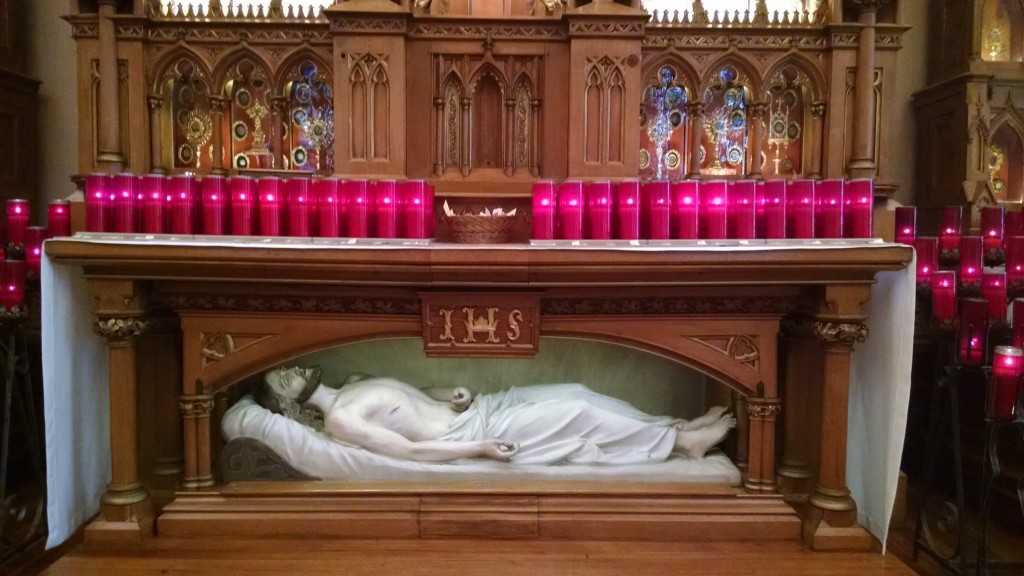 Both were immigrants; one a missionary priest, the other a lay Catholic schoolmaster who’d studied for the priesthood.
Both were immigrants; one a missionary priest, the other a lay Catholic schoolmaster who’d studied for the priesthood.
The priest became celebrated for spreading his mission a half-world removed from his native land. The schoolteacher became celebrated for spreading, well, manure. But he devised a way to accomplish that vital farm task better than anyone had before, after an inspiration from a schoolyard game led to his revolutionary technique for fertilizing crops.
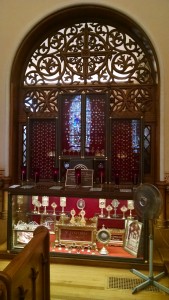 Their lifetimes barely overlapped. The priest died on a return trip to Europe the same year the schoolteacher was born. But their legacies, of missionary zeal on the one hand and rural resourcefulness on the other, intersect in Maria Stein, Ohio, home of a Catholic shrine where thousands of visitors each year pass through chapel doors beneath the inscription “Enter devoutly, O Pilgrim, for no place is holier than this on the New Continent.”
Their lifetimes barely overlapped. The priest died on a return trip to Europe the same year the schoolteacher was born. But their legacies, of missionary zeal on the one hand and rural resourcefulness on the other, intersect in Maria Stein, Ohio, home of a Catholic shrine where thousands of visitors each year pass through chapel doors beneath the inscription “Enter devoutly, O Pilgrim, for no place is holier than this on the New Continent.”
Father Francis de Sales Brunner, born in 1795 to a German-speaking family in northern Switzerland, entered the Benedictines’ Mariastein Abbey there at age 17. The abbey’s location had drawn pilgrims since the 1300s, dedicated to Maria Stein (“Mary of the Rock”) whose intervention was credited with the miraculous survival of a boy who fell from a cliff onto a rock at the site.
A decade after Father Brunner’s ordination he sought a more demanding life, leading him to take Trappist vows. He remained with the Trappists until they were suppressed following the Second French Revolution. Father Brunner then bought the castle of Löwenberg and converted it to a school.
During this period he and his widowed mother made a pilgrimage to Rome, where they were enrolled in the Archconfraternity of the Most Precious Blood. After returning home, she founded the Sisters of the Precious Blood and was thereafter known as Mother Maria Anna Brunner.
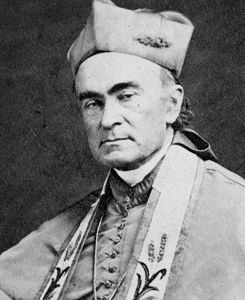 Her son came to America at the invitation of Cincinnati Archbishop John Baptist Purcell (right), who was anxious to provide clergy for the region’s German immigrants. Father Brunner arrived in Cincinnati on New Year’s Day 1844 with seven other Precious Blood priests. The first sisters of Mother Brunner’s congregation followed that summer.
Her son came to America at the invitation of Cincinnati Archbishop John Baptist Purcell (right), who was anxious to provide clergy for the region’s German immigrants. Father Brunner arrived in Cincinnati on New Year’s Day 1844 with seven other Precious Blood priests. The first sisters of Mother Brunner’s congregation followed that summer.
The missionaries established a number of parishes, schools, and convents. The work included the founding of the Maria Stein convent in the Mercer County farm community that became its namesake.
Father Brunner had previously acquired a number of relics that he and the sisters brought to America. In the 1870s, Father J.M. Gartner, vicar general of the Milwaukee diocese, amassed another collection after visiting Rome and recoiling in horror at the looting and sale of sacred items amid the period’s rising anti-clericalism. With the blessing of Pope Pius IX, Father Gartner moved some 175 relics to the United States for safekeeping.
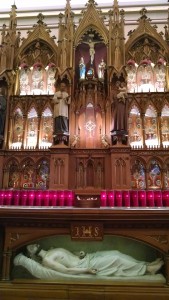 Hearing of the relics already present at Maria Stein, Father Gartner entrusted his collection to the Sisters of the Precious Blood. The sisters have overseen the combined collections ever since. It was only last week that the congregation announced an end to this caretaker ministry: Next New Year’s Day, a lay nonprofit will assume responsibility for the shrine.
Hearing of the relics already present at Maria Stein, Father Gartner entrusted his collection to the Sisters of the Precious Blood. The sisters have overseen the combined collections ever since. It was only last week that the congregation announced an end to this caretaker ministry: Next New Year’s Day, a lay nonprofit will assume responsibility for the shrine.
Maria Stein’s treasures include a splinter of the True Cross, the mortal remains of St. Victoria, and other relics spanning the apostolic age to our own time. Maria Stein Shrine of the Holy Relics is the second-largest such shrine in the United States (after St. Anthony Chapel in Pittsburgh, with more than 5,000). Some 95% of Maria Stein’s collection is composed of saints’ physical remains, classified as “first-class” relics. The collection continued to grow over the years, including through donations from two Cincinnati archbishops, John T. McNicholas and Karl J. Alter. Recent additions include relics of St. Pope John Paul II and St.Theresa of Calcutta.
The shrine, open to the public, sits just up the road from St. John the Baptist Church, a Romanesque Revival structure whose pastors lived at Maria Stein Convent until the parish rectory was completed 100 years ago this fall. Masses were first celebrated at a log church there in 1837, followed by a brick building in 1850 and the current one, dedicated in 1891.
Just outside the present church, a historical marker’s chronology includes the notation:
1847: Maria Stein Convent founded by Rev. Francis de Sales Brunner.
Followed a few lines below by this one:
1899: Joseph Oppenheim, a local teacher, began the New (Idea) Spreader Company.
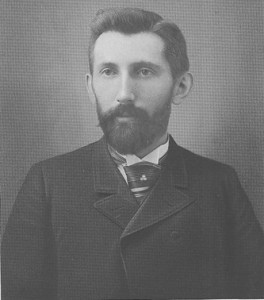 Oppenheim (right) was a German immigrant who taught at Maria Stein’s single-room Catholic schoolhouse. A neighbor, John M. Kramer, and two other men (including Oppenheim’s future son-in-law, Henry Synck) had patented a wagon capable of unloading manure via a drag chain and beaters, which deposited the fertilizer directly behind as horses drew the wagon over the farmland. Kramer’s mechanism provided an obvious improvement over shoveling, but laborers still needed to spread the fertilizer across the soil, a backbreaking task.
Oppenheim (right) was a German immigrant who taught at Maria Stein’s single-room Catholic schoolhouse. A neighbor, John M. Kramer, and two other men (including Oppenheim’s future son-in-law, Henry Synck) had patented a wagon capable of unloading manure via a drag chain and beaters, which deposited the fertilizer directly behind as horses drew the wagon over the farmland. Kramer’s mechanism provided an obvious improvement over shoveling, but laborers still needed to spread the fertilizer across the soil, a backbreaking task.
When fire destroyed Kramer’s machine shop, the story goes, Oppenheim loaned him money to rebuild. When the revived business sagged, Oppenheim accepted the patent as repayment.
That got Oppenheim thinking about improvements in the design.
An account of what followed was published years later in a World War I-era magazine advertisement.
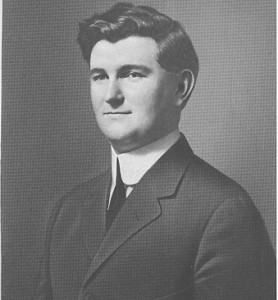 The text, attributed to the inventor’s son B.C. Oppenheim (right), noted how settlers “knew that land could be exhausted – they knew it must be fed if it was to continue feeding them. So they wasted little fertilizer. Barnyard manure was their reliance – as it is yet.
The text, attributed to the inventor’s son B.C. Oppenheim (right), noted how settlers “knew that land could be exhausted – they knew it must be fed if it was to continue feeding them. So they wasted little fertilizer. Barnyard manure was their reliance – as it is yet.
“Hence it was scattered on the fields with great care. My father made a hand in this labor occasionally. The children from his school bent weary backs over the task. Their drudgery appealed to his heart. He knew what it meant in aching muscles, neglected schooling and dwarfed opportunity. He knew that such machines as were available neither shredded the manure nor spread it wide. So he set out to build a machine that would do this and save hard work.”
The elder Oppenheim thought of a game his students played, a baseball variation in which balls were batted with flat paddles.
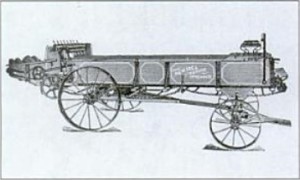 He thought of how the paddles deflected balls at different angles depending on points of impact. He conceived a “widespreader” featuring wooden paddles attached to a shaft, designed to distribute the fertilizer sideways in wide, uniform layers. He and B.C. tested the concept on a cigar box fitted with a rotary paddle distributor. As the advertisement quoted B.C.: “It’s a long story of how the village teacher saved a nickel here and a dime there, worked early mornings and late nights and eventually built a spreader that carried the principles that make the New Idea the leader today.
He thought of how the paddles deflected balls at different angles depending on points of impact. He conceived a “widespreader” featuring wooden paddles attached to a shaft, designed to distribute the fertilizer sideways in wide, uniform layers. He and B.C. tested the concept on a cigar box fitted with a rotary paddle distributor. As the advertisement quoted B.C.: “It’s a long story of how the village teacher saved a nickel here and a dime there, worked early mornings and late nights and eventually built a spreader that carried the principles that make the New Idea the leader today.
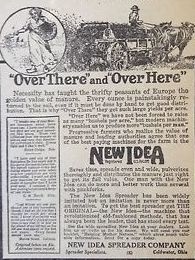 “So much better was it than the old method of wagon tail distribution that the sturdy farmers called it ‘Oppenheim’s New Idea.’ After a while when the work had been brought to a practical stage, we called ourselves the New Idea Spreader Company.”
“So much better was it than the old method of wagon tail distribution that the sturdy farmers called it ‘Oppenheim’s New Idea.’ After a while when the work had been brought to a practical stage, we called ourselves the New Idea Spreader Company.”
In 1901, about two years after Joseph Oppenheim’s production shop opened, he died of typhoid fever. But his insurance policy provided the family with means to grow the company. B.C. Oppenheim replaced his father as president of the expanding business, which opened a manufacturing plant in nearby Coldwater in 1907. Within 10 years, New Idea expanded operations to several states and Canada, achieving annual sales comparable to about 30 million in today’s dollars. The family sold the company just after World War II, and, after some changes in ownership over the years, New Idea was acquired in the 1990s by Agco, which closed the Coldwater plant in 1999.
Joseph Oppenheim is buried in St. John Catholic Cemetery, next to the church and along the road to the shrine.
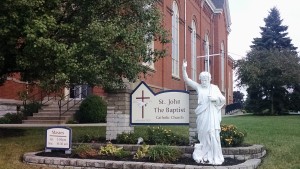 The parish’s union of purpose with the archdiocese, a union that led to the coming of the Precious Blood ministries in the 19th century, remains strong in the 21st. Parishioners have responded to One Faith, One Hope, One Love – the archdiocesan capital campaign – by raising 133% of their local goal, and plan to use a portion of their parish share to expand the cemetery.
The parish’s union of purpose with the archdiocese, a union that led to the coming of the Precious Blood ministries in the 19th century, remains strong in the 21st. Parishioners have responded to One Faith, One Hope, One Love – the archdiocesan capital campaign – by raising 133% of their local goal, and plan to use a portion of their parish share to expand the cemetery.
With its heritage and expanding legacy, may Maria Stein’s blessings remain bountiful, a harvest in Heaven and on Earth.
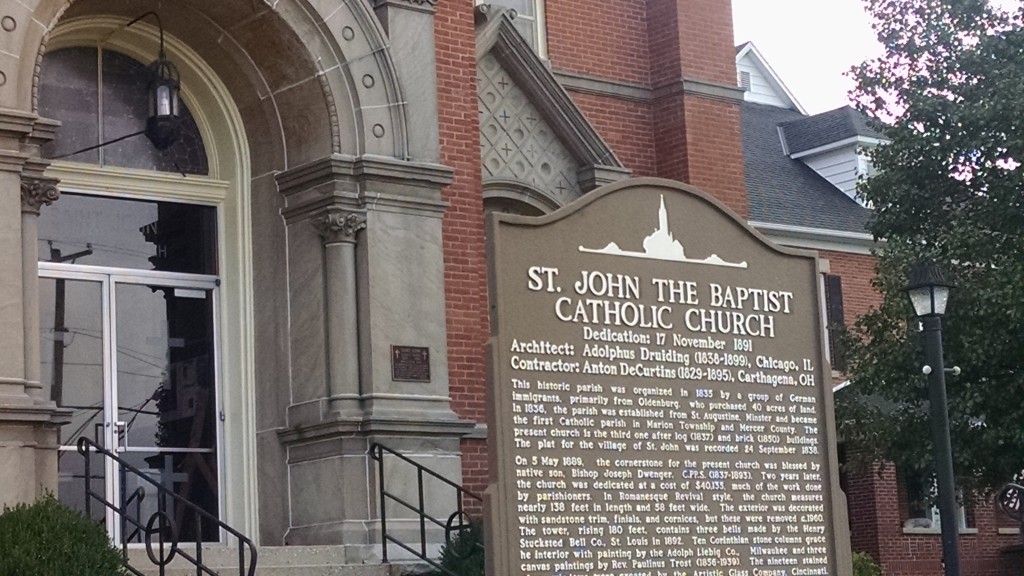
Posted:
Go To News Story Archives

